![]()
Recent Articles

Get
all the evaluations for
the January
Release
Subscribe
to Vintage Assessments today
by Clicking
Here
This
not-for-profit website is dedicated to the discerning reader!
Getting
the best of what’s not available at the LCBO
Consignment Discoveries from New Zealand
National Post Weekly Wine & Spirits Columnist
Saturday, November 29, 2003
www.winefind.ca
(All
wines/spirits listed below are automatically linked to the
lcbo database)
If there is a product that interests you, just
click on the name below
and you will instantaneously connected with the LCBO database. The product
will appear in blue and all you have to do is click on the name again and then the next screen will provide
details along with the store search. Just click on store
search. The number of bottles in each store is updated nightly.
You should call the store first to see if stock still remains (each store
phone number is listed).
There
is no question that the LCBO carries a lot of imported wine, more than any
mere mortal can taste. Nevertheless, there’s always a host of very fine
products that, for whatever reason, do not end up on LCBO shelves. If you
are interested in tracking down the host available but unlisted wines, you
have to check with those agents
carring “consignment” wines, which can only be stored in a LCBO bonded
warehouse.
Recently,
I received an extensive list of consignment wines featured by the Lifford
agency. I spotted a white I definitely wanted to buy. I then noticed I had
to buy no less than 12 bottles. It seems that this discriminatory LCBO
requirement has been around forever. The sheer insanity of it all really
irked me. Why is it that the LCBO only forces importers to sell no less
than a whole case of wine? I was told that age-old LCBO promises of a
policy review of this unfair regulation have that all-too-familiar hollow
ring. Nothing changes!
How
can it be that the LCBO and any Ontario winery can ship exactly the number
of bottles they like, while importers are bound and gagged. I wanted to
yell “vive importers libre!” Unfortunately, it means that one can’t
buy less than a case (usually 12 bottles) of any of the consignment wines
I am recommending today.
Digging
deeper, one discovers that this uneven playing field becomes even more
stilted. For instance, when an Ontario winery decides not to sell a wine
through the LCBO (i.e. directly to the customer), the entire LCBO mark up
plus wine levy is handed over to the winery. On a bottle costing $19.95,
the winery receives an additional $6.43 on top of the $9.32
profit-inclusive basic cost of the bottle – a total of $15.75.
Not
so with consignment wines where basically the LCBO still pockets the full
mark-up for doing what? On a wine selling for $19.95, for instance, the
off-shore winery receives $8.10, the agent receives nothing unless the
winery gives him part of that $8.10. Surely the importer who undertakes to
sell these wines is entitled to equal treatment as an Ontario producer.
To
cover the costs of pick-up and delivery along with administrative
overhead, agents are forced to sell such consignment wines at a premium
over LCBO cost. This fee, which I have been told has been decreed as being
illegal by the LCBO, might be as low as $1 per bottle and rise to more
than a 20% mark-up over cost. These higher prices obviously penalize
consumers for buying consignment wines. The fact that some agents have
imposed huge mark-ups hasn’t help the cause.
It
is also worth noting that the LCBO have been operating their own secretive
“licensees only” consignment program, essentially competing with
existing consignment agents. Ironically, the LCBO refuses to let the
general public access these wines. While the LCBO Chairman likes to
suggest that it’s a very competitive world out there, it is clear that
LCBO actions speak louder than its words. All these restrictions, along
with the fact that wine importers cannot be in possession of more than 20
cases of wine at any point in time, makes virtually every agent a law
breaker! Hopefully the new Liberal government will address these unfair
Tory-installed regulations.
Moving
on, Lifford carries dozens of
consignment wines (to get the list call 1-877-272-1720). While planning to
focus on New Zealand wines, I had been moved by an exciting Australian
Sauvignon Blanc making a slight detour necessary.
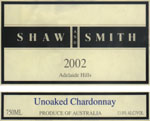 It
was a happy day for wine lovers when cousins Martin Shaw (winemaker) and
Master of Wine Michael Hill Smith decided over long lunch in 1989 to form
Shaw and Smith. Their 28-ha Woodside Vineyard is located in the Adelaide
Hills, they
It
was a happy day for wine lovers when cousins Martin Shaw (winemaker) and
Master of Wine Michael Hill Smith decided over long lunch in 1989 to form
Shaw and Smith. Their 28-ha Woodside Vineyard is located in the Adelaide
Hills, they 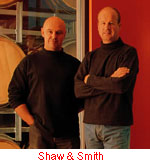 focused on cool climate styled Sauvignon Blanc (16-ha) and
Chardonnay (12-ha) for 10 years before branching out into Riesling and
Pinot Noir. Shaw & Smith 2002
Sauvignon Blanc
(851139)
at $24.92 is one of the few in Australia that can challenge New
Zealand’s best. Ironically, it was the Shaw & Smith 2002 Unoaked Chardonnay (851147
- $24.92) that really swept me away. The seductive, rhubarb-tinged, ripe
grapefruit nose was followed by bright,
dry but harmonious, lemony, ripe pear flavours made this crowd-pleaser a
real winner. For further information on Shaw and Smith click here
focused on cool climate styled Sauvignon Blanc (16-ha) and
Chardonnay (12-ha) for 10 years before branching out into Riesling and
Pinot Noir. Shaw & Smith 2002
Sauvignon Blanc
(851139)
at $24.92 is one of the few in Australia that can challenge New
Zealand’s best. Ironically, it was the Shaw & Smith 2002 Unoaked Chardonnay (851147
- $24.92) that really swept me away. The seductive, rhubarb-tinged, ripe
grapefruit nose was followed by bright,
dry but harmonious, lemony, ripe pear flavours made this crowd-pleaser a
real winner. For further information on Shaw and Smith click here
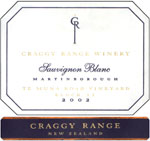 Of
three excellent Sauvignon Blanc tasted, the best was Craggy Range 2002 Sauvignon
Blanc Te Muna Road Vineyard Block 11 Martinborough
(798975)
at $28.30. A solid, still youthful effort with
14.4% alcohol, it has grassy, dusty, ripe lemon flavours with a lingering
herbal finish. It could still
Of
three excellent Sauvignon Blanc tasted, the best was Craggy Range 2002 Sauvignon
Blanc Te Muna Road Vineyard Block 11 Martinborough
(798975)
at $28.30. A solid, still youthful effort with
14.4% alcohol, it has grassy, dusty, ripe lemon flavours with a lingering
herbal finish. It could still  use another 8 months or so to evolve and
will definitely appeal to those who appreciate a gutsy, dry style. At 29,
American-born Doug Wisor has done fine things at Craggy Range. He was in
Toronto recently at the Vintages Young Winemakers event and some 7 cases
of this wine will be sent to various LCBO stores in the near future
(919530 - $27.95). For further information on Craggy Range
click
here
use another 8 months or so to evolve and
will definitely appeal to those who appreciate a gutsy, dry style. At 29,
American-born Doug Wisor has done fine things at Craggy Range. He was in
Toronto recently at the Vintages Young Winemakers event and some 7 cases
of this wine will be sent to various LCBO stores in the near future
(919530 - $27.95). For further information on Craggy Range
click
here
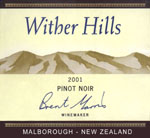 The
preview blind tasting featured two New Zealand Pinot Noirs, which were
extremely impressive, although different in style. The elegant
Marlborough-based Wither
Hills 2001 Pinot Noir (831016 - $44.35) has an attractive,
bright ripe black cherry scented nose and fine, bright, fairly juicy,
harmonious, ruby grapefruit, dried ripe red cherry flavours that are
showing very nicely. For further information on Wither Hills click here
The
preview blind tasting featured two New Zealand Pinot Noirs, which were
extremely impressive, although different in style. The elegant
Marlborough-based Wither
Hills 2001 Pinot Noir (831016 - $44.35) has an attractive,
bright ripe black cherry scented nose and fine, bright, fairly juicy,
harmonious, ruby grapefruit, dried ripe red cherry flavours that are
showing very nicely. For further information on Wither Hills click here
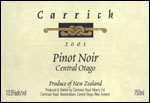 While
the latter effort from the northern tip of the South Island resembles a
fine Beaune, the next Pinot Noir from the most southerly reaches of New
Zealand had shades of classic Mazis-Chambertin. From Central Otago region,
the recently-launched Carrick
2001 Cairnmuir Road Pinot Noir (887497) at
$52.62 is definitely worth a detour. Look for
well balanced, solid, dry but not austere, medium-full bodied, slightly
piquant, dried ripe black cherry flavours that show fine length and
mouthfeel. Excellent today, this one can still evolve over the next 12
months. For further information on Carrick
click here
While
the latter effort from the northern tip of the South Island resembles a
fine Beaune, the next Pinot Noir from the most southerly reaches of New
Zealand had shades of classic Mazis-Chambertin. From Central Otago region,
the recently-launched Carrick
2001 Cairnmuir Road Pinot Noir (887497) at
$52.62 is definitely worth a detour. Look for
well balanced, solid, dry but not austere, medium-full bodied, slightly
piquant, dried ripe black cherry flavours that show fine length and
mouthfeel. Excellent today, this one can still evolve over the next 12
months. For further information on Carrick
click here
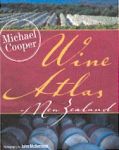 Those wanting to know more should seek out the outstanding hot-off-the
press Wine Atlas of New Zealand by Michael Cooper ($96.95). Unfortunately, I couldn’t find a
single Toronto bookstore that stocked it! Chapters-Indigo offer it on
their website at a great discount, but will it be delivered before
Christmas? It’s hard to believe that the Canadian distributor has only a
single copy in stock for the entire country! Isn’t it time that the
publisher find a more pro-active distributor! Fortunately, the New Zealand
Wine Growers (rketchin@ketchin.com),
however, have 4 copies immediately available at $85 (plus shipping and
taxes). Let me assure you that it is indispensable for anyone planning to
attend the biannual world conference Pinot
Noir 2004 in Wellington from January 28-31. This celebration will
bring delegates and international winemakers to New Zealand’s capital
for three days. It features of top level national and international
speakers, quality cuisine and a multitude of tastings. The program
includes nine overseas winemakers and 99 New Zealand wineries. For
information on the event click here
Those wanting to know more should seek out the outstanding hot-off-the
press Wine Atlas of New Zealand by Michael Cooper ($96.95). Unfortunately, I couldn’t find a
single Toronto bookstore that stocked it! Chapters-Indigo offer it on
their website at a great discount, but will it be delivered before
Christmas? It’s hard to believe that the Canadian distributor has only a
single copy in stock for the entire country! Isn’t it time that the
publisher find a more pro-active distributor! Fortunately, the New Zealand
Wine Growers (rketchin@ketchin.com),
however, have 4 copies immediately available at $85 (plus shipping and
taxes). Let me assure you that it is indispensable for anyone planning to
attend the biannual world conference Pinot
Noir 2004 in Wellington from January 28-31. This celebration will
bring delegates and international winemakers to New Zealand’s capital
for three days. It features of top level national and international
speakers, quality cuisine and a multitude of tastings. The program
includes nine overseas winemakers and 99 New Zealand wineries. For
information on the event click here
2001-2002-2003 Tasting Note Database
Our tasting note database from December 3 1, 2000 to November 2003, covers every Vintages release product for the past 34 months. There are more than 5,000 notes in the database data. Just enter the name of the product, supplier name or CSPC number. Or you can search by type of wine, country of origin, even wine agent! Nothing could be easier. Also you can get information on the agent by clicking on the agent’s name, as well as current LCBO store inventory by clicking on "Check LCBO Availability", which will automatically tell you the number of bottles at LCBO as of last night.
To use our winefind.ca Tasting Notes Database: click here
Subscribe to Vintage Assessments Today • Click Here
|
** For All Visitors ** |
Copyright Gargoyles
Limited 2003
Prior written permission is required for any form of reproduction
(electronic or other wise) and or quotation.
Contact Michael Vaughan at
mbv@total.net